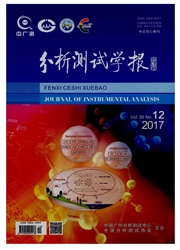

 中文摘要:
中文摘要:
将中红外光谱筛选出的598个纯涤、纯棉及涤/棉混纺样本采用GB/T 2910.11-2009法测定其涤、棉准确含量,其中校正集样本252个,验证集样本346个。使用便携式近红外光谱仪获取样本的原始近红外光谱(NIRS)。校正集样本依据回归系数的分布趋势和范围选取最佳建模谱区,并采用差分一阶导、S-G平滑和均值中心化相结合的方法对原始光谱进行预处理,利用偏最小二乘法(PLS)建立涤/棉混纺织物中涤含量的近红外(NIR)定量分析模型。同时分析了样本颜色对NIRS的影响,探讨了斜线光谱样本、奇异样本和不同组织结构织物对模型预测效果的影响。结果表明:利用PLS法建立的涤/棉混纺织物定量分析模型最优组合包含1个光谱区间和9个主成分因子,校正集相关系数(RC)为0.998,标准偏差(SEC)为0.908。为验证所建模型的有效性和实用性,对346个未参与建模的涤棉样本进行了预测,并将预测结果与国标法测定值进行方差分析,两种方法结果无显著差异,预测正确率达97%以上。模型的建立为废旧涤/棉混纺织物快速、无损分拣提供了基础数据库。
 英文摘要:
英文摘要:
A series of 598 pure polyester, pure cotton and polyester - cotton blended samples were selected by FT - MIR, and their relative contents were determined by the national standard method (GB/T 2910. 11 - 2009). The samples original spectra were acquired by near-infrared(NIR) spectrometry, which were distributed into the calibration set (252 samples ) and the validation set (346 samples). The best modeling spectra were obtained according to the size and trend range of regression coefficient distribution. Using preprocessing such as S - G smoothing, Differential 1 st derivative and mean centering to analyze the samples NIRS, and the NIR quantitative analysis model for polyes- tercotton blended fabrics was established by partial least squares (PLS) method. The influence of sample's color on the NIRS was analyzed, and the effects of slash spectrum samples, singular samples and fabric stitch structure of samples on the prediction accuracy of the model were investigated. The result of experiment indicated that the NIR quantitative analysis model for polyester - cotton blended fabrics was established by PLS method, which included 1 spectral interval and 9 principal factors. The correlation coefficient of calibration and the standard errors of calibration were obtained to be 0. 998 and 0. 908, respectively. To verify the accuracy, validity and practicability of the model,346 bound samples were predicted. The variance analysis indicated that there was no significant difference between NIR method and national standard method, and the aecurate reeognition rate reaehes up to 97% . The model will provide a foundation database for sorting the waste polyester - cotton blended fabrics quickly and non-destructively.
 同期刊论文项目
同期刊论文项目
 同项目期刊论文
同项目期刊论文
 期刊信息
期刊信息
